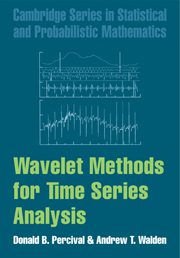Book contents
- Frontmatter
- Contents
- Preface
- Conventions and Notation
- 1 Introduction to Wavelets
- 2 Review of Fourier Theory and Filters
- 3 Orthonormal Transforms of Time Series
- 4 The Discrete Wavelet Transform
- 5 The Maximal Overlap Discrete WaveletTransform
- 6 The Discrete Wavelet Packet Transform
- 7 Random Variables and StochasticProcesses
- 8 The Wavelet Variance
- 9 Analysis and Synthesis of Long MemoryProcesses
- 10 Wavelet-Based Signal Estimation
- 11 Wavelet Analysis of Finite EnergySignals
- Appendix. Answers to Embedded Exercises
- References
- Author Index
- Subject Index
2 - Review of Fourier Theory and Filters
Published online by Cambridge University Press: 05 December 2013
- Frontmatter
- Contents
- Preface
- Conventions and Notation
- 1 Introduction to Wavelets
- 2 Review of Fourier Theory and Filters
- 3 Orthonormal Transforms of Time Series
- 4 The Discrete Wavelet Transform
- 5 The Maximal Overlap Discrete WaveletTransform
- 6 The Discrete Wavelet Packet Transform
- 7 Random Variables and StochasticProcesses
- 8 The Wavelet Variance
- 9 Analysis and Synthesis of Long MemoryProcesses
- 10 Wavelet-Based Signal Estimation
- 11 Wavelet Analysis of Finite EnergySignals
- Appendix. Answers to Embedded Exercises
- References
- Author Index
- Subject Index
Summary
Introduction
In subsequent chapters we will make substantial use of some basic results from the Fourier theory of sequences and – to a lesser extent – functions, and we will find that filters play a central role in the application of wavelets. This chapter is intended as a self-contained guide to some key results from Fourier and filtering theory. Our selection of material is intentionally limited to just what we will use later on. For a more thorough discussion employing the same notation and conventions adopted here, see Percival and Walden (1993). We also recommend Briggs and Henson (1995) and Hamming (1989) as complementary sources for further study.
Readers who have extensive experience with Fourier analysis and filters can just quickly scan this chapter to become familiar with our notation and conventions. We encourage others to study the material carefully and to work through as many of the embedded exercises as possible (answers are provided in the appendix). It is particularly important that readers understand the concept of periodized filters presented in Section 2.6 since we use this idea repeatedly in Chapters 4 and 5.
Complex Variables and Complex Exponentials
The most elegant version of Fourier theory for sequences and functions involves the use of complex variables, so here we review a few key concepts regarding them (see, for example, Brown and Churchill, 1995, for a thorough treatment). Let i ≡ √–1 so that i2 = –1 (throughout the book, we take ‘≡’ to mean ‘equal by definition’).
- Type
- Chapter
- Information
- Wavelet Methods for Time Series Analysis , pp. 20 - 40Publisher: Cambridge University PressPrint publication year: 2000



